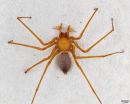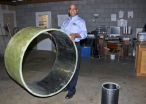(Press-News.org) The Department of Homeland Security (DHS) Science and Technology Directorate's (S&T) new low-cost device for dismantling dangerous pipe bombs may look like a tinkerer's project, but that's no accident. The Semi Autonomous Pipe Bomb End-cap Remover (SAPBER) is unassuming in appearance, but sophisticated enough to preserve the forensic evidence needed to track down the perpetrator.
"From ten paces away, you might mistake the contraption for a pressure washer," says S&T Program Manager Christine Lee. "But step closer and you'll find an ingenious device bristling with four video cameras, radios, a telescoping mast, cutting wheels, a twisting wrist, an electric motor, and a chain-driven gear, all powered by a pair of 12-volt batteries."
Thousands of pipe bombs are made each year, and thousands of pipe bomb threats are called into local police and FBI authorities across the country. Many are false alarms, but those that aren't can be deadly.
Dismantling a pipe bomb is tricky and serious business, and missteps during the dismantling process can produce catastrophic results. Law enforcement authorities ideally would like to preserve all evidence related to pipe bomb attacks, but the main focus of responders is the safety of the public and current pipe bomb render-safe techniques often limit the amount of evidence that can be collected. Not so with SAPBER (say-ber).
Pipe bombs can be constructed from many different pipe materials, and filled with many different explosive materials. Making it even more challenging, they can also be constructed with shrapnel on the outside. SAPBER is designed to carefully disassemble the pipe bomb without disturbing the deadly explosive materials inside. Once the pipe bomb is dismantled, the filler explosive materials can then be emptied, and both materials and the pipe itself can be preserved as evidence. The SAPBER system is able to use these special techniques on a wide variety of pipes including straight steel, galvanized steel, copper, and PVC plumbing plastic.
The prototype and its remote-control software were developed by RE2 Inc., of Pittsburgh, Pennsylvania. As an operator controls the device from a distance, SAPBER takes the pipe bomb from a bomb-disposal robot, disassembles it, empties the pipe, makes a video, and carefully preserves all of the evidence.
The 140-pound (64-kg) two-wheeler is small enough to squeeze into a current bomb-squad truck while sharing space with a bomb-disposal robot. Once off the truck, SAPBER is towed into place by hand or by the robot. On-scene, the robot lifts the pipe bomb and gently lays it onto SAPBER's transfer tray to be cleanly disassembled. When the pipe is opened, the material inside—powder, detonator, shrapnel, and all—fall into SAPBER's collection trough, to be studied later and used as evidence.
In May, SAPBER underwent trials conducted by the S&T Bomb Squad Test Bed at the Army's Fort Meade. During these trials, the Bureau of Alcohol, Tobacco, Firearms, and Explosives (ATF) fabricated "live" pipe bombs for the Baltimore County Police Department Bomb Squad to test in four different, operational scenarios and each operator had to control SAPBER remotely, using the tool's video feed. The SAPBER system has also been tested using "live" explosives and has gone through an extensive evaluation by several bomb squads including the Allegheny County and Fairfax County Bomb Squads.
"To keep it affordable (currently around $12,000) and easy to maintain, RE2 Inc. designed and built the device from proven commercial parts that are mass-produced and easily replaced," says Lee.
Everything that S&T's First Responders Group (FRG/R-Tech) funds must appeal to cash-strapped, cost efficient responders. If SAPBER looks more like a boy's go-cart, and not a sleek racecar, that's no matter to them. Cost saving is a practice encouraged by S&T's First Responders Group (FRG), whose R-Tech program funded SAPBER's development. The final design was shown to the National Bomb Squad Commander's Advisory Board and municipal bomb squads, and SAPBER proved its mettle—at the conclusion of the user evaluation, two SAPBER prototypes were transferred to ATF to disarm the scores of pipe bombs its agents have confiscated.
Bomb Squad Commander Corporal Robert Conroy of the Baltimore County Police Department – Hazardous Devices Team says: "The most unique feature of the SAPBER is its simplicity and ease of use. Personally, I liked that the operating system was computer based and didn't require any extra hardware outside of a standard modem and Wi-Fi hotspot (included with the SAPBER). In addition, the ability of the SAPBER to remotely dismantle pipe bombs in various ways is very unique."
According to Cathy Parker, RE2's Manager of Business Development, "With the SAPBER system, bomb squads will be able to replace dangerous pipe bomb disassembly tools and techniques with a totally remote solution. This tool ushers in a new era of capability for dealing with pipe bombs."
"This means disarming a pipe bomb safely is no longer a pipe dream," says Lee.
INFORMATION:
Taking the edge off a pipe bomb -- literally
Mobile mechanism from Homeland Security dismantles a pipe bomb while preserving the evidence
2012-08-17
ELSE PRESS RELEASES FROM THIS DATE:
Spider version of Bigfoot emerges from caves in the Pacific Northwest
2012-08-17
The forests of the coastal regions from California to British Columbia are renowned for their unique and ancient animals and plants, such as coast redwoods, tailed frogs, mountain beavers and the legendary Bigfoot (also known as Sasquatch). Whereas Bigfoot is probably just fiction, a huge, newly discovered spider is very real. Trogloraptor (or "cave robber") is named for its cave home and spectacular, elongate claws. It is a spider so evolutionarily special that it represents not only a new genus and species, but also a new family (Trogloraptoridae). Even for the species-rich ...
Trained NHS therapists can help insomniacs
2012-08-17
Insomnia sufferers in England could have greater access to successful treatment, thanks to a training programme developed as part of trials of Cognitive Behaviour Therapy for Insomnia (CBTi), funded by the Economic and Social Research Council (ESRC).
In Britain, people report having insomnia more often than any other psychological condition, including anxiety, depression and even pain, according to the Office of National Statistics. Yet the only treatment offered in most doctors' surgeries is a course of sleeping tablets.
"It is well known that sleeping pills can be ...
UA engineering professor uses aerospace materials to build endless pipeline
2012-08-17
TUCSON, Ariz. (August 17, 2012) -- Mo Ehsani, Professor Emeritus of Civil Engineering at the University of Arizona, has designed a new, lightweight underground pipe he says could transform the pipeline construction industry.
Instead of conventional concrete or steel, Ehsani's new pipe consists of a central layer of lightweight plastic honeycomb, similar to that used in the aerospace industry, sandwiched between layers of resin-saturated carbon fiber fabric.
In combination, these materials are as strong, or stronger, than conventional steel and concrete pipes, which ...
It must be important but what does it do? The strange case of UCP2
2012-08-17
When uncoupling proteins are active, mitochondria produce heat instead of ATP. This may be useful under certain circumstances, such as when an animal is hibernating. But non-hibernating animals also have them. Particularly poorly understood is the uncoupling protein UCP2. Elena Pohl and colleagues at the University of Veterinary Medicine, Vienna, show that the protein occurs mainly in cells of the immune system. The group's highly provocative findings are published in the online journal PLOS ONE.
Mitochondria represent the powerhouses of the eukaryotic cell. They ...
Iconic Darwin finch genome sequenced in Genome 10K international collaboration
2012-08-17
Santa Cruz, California—Scientists have sequenced the genome of one of the iconic Galapagos finches first described by Charles Darwin. The genome of the medium ground finch (Geospiza fortis) is among the first of a planned 100 genomes of vertebrate species to be sequenced and released by an international collaboration between the Genome 10K project and BGI.
This finch genome, the first of the BGI-Genome 10K collaboration to be made available through the UCSC Genome Browser, represents both a scientific and a symbolic advancement, according to Duke University associate professor ...
Magnetic turbulence trumps collisions to heat solar wind
2012-08-17
New research, led by University of Warwick physicist Dr Kareem Osman, has provided significant insight into how the solar wind heats up when it should not. The solar wind rushes outwards from the raging inferno that is our Sun, but from then on the wind should only get cooler as it expands beyond our solar system since there are no particle collisions to dissipate energy. However, the solar wind is surprisingly hotter than it should be, which has puzzled scientists for decades. Two new research papers led by Dr Osman may have solved that puzzle.
Turbulence pervades ...
Wild pollinators support farm productivity and stabilize yield
2012-08-17
Most people are not aware of the fact that 84% of the European crops are partially or entirely dependent on insect pollination. While managed honeybees pollinate certain crops, wild bees, flies and wasps cover a very broad spectrum of plants, and thus are considered the most important pollinators in Europe.
The serious decline in the number of managed honeybees and wild bees reported in Europe over the last few decades has the potential to cause yield decreases with threats to the environment and economy of Europe. The future of the pollination services provided by bees ...
War is not necessarily the cause of post-traumatic stress disorder
2012-08-17
A large-scale survey of the mental condition of military personnel before, during and after their posting to Afghanistan has proved thought-provoking. In total, 746 Danish soldiers took part in the survey. The soldiers completed a questionnaire five times in all – before their posting, during their time in Afghanistan and three times after their return to Denmark.
Professor Dorthe Berntsen of the Center on Autobiographical Memory Research – CON AMORE, Department of Psychology, Aarhus University, Business and Social Sciences, is responsible for the study, together with ...
Photographic cholesterol test
2012-08-17
Researchers in India have developed a total cholesterol test that uses a digital camera to take a snapshot of the back of the patient's hand rather than a blood sample. The image obtained is cropped and compared with images in a database for known cholesterol levels.
Writing in the International Journal of Medical Engineering and Informatics, N.R. Shanker of the Sree Sastha Institute of Engineering and Technology and colleagues describe how they have developed a non-invasive way to test cholesterol levels in patients at increased risk of heart disease. Their approach ...
Regions vary in paying prisoners to participate in research
2012-08-17
TORONTO, Aug. 17, 2012--When members of the public participate in research studies, they are often given incentives – such as cash or gift cards for food – as compensation or reimbursement for their time and effort. Not so for Canada's prison population. A new analysis shows that there is inconsistency in how and when incentives are used for research participants under criminal justice supervision.
Of the provinces, territories and federal government, only two jurisdictions have written policy around the use of research incentives, according to a national study led by ...
LAST 30 PRESS RELEASES:
New circoviruses discovered in pilot whales and orcas from the North Atlantic
Study finds increase in risk of binge drinking among 12th graders who use 2 or more cannabis products
New paper-based technology could transform cancer drug testing
Opioids: clarifying the concept of safe supply to save lives
New species of tiny pumpkin toadlet discovered in Brazil highlights need for conservation in the mountain forests of Serra do Quiriri
Reciprocity matters--people were more supportive of climate policies in their country if they believed other countries were making significant efforts themselves
Stanford Medicine study shows why mRNA-based COVID-19 vaccines can cause myocarditis
Biobanking opens new windows into human evolution
Sky-high smoke
AI tips off scientists to new drug target to fight, treat mpox
USC researchers develop next-generation CAR T cells that show stronger, safer response in animal models
New study reveals Industrial Revolution’s uneven health impacts across England
Vine-inspired robotic gripper gently lifts heavy and fragile objects
Fingerprint of ancient seafarer found on Scandinavia’s oldest plank boat
Lunar soil analyses reveal how space weathering shapes the Moon’s ultraviolet reflectance
Einstein’s theory comes wrapped up with a bow: astronomers spot star “wobbling” around black hole
Danforth Plant Science Center to lead multi-disciplinary research to enhance stress resilience in bioenergy sorghum
Home-delivered groceries improve blood sugar control for people with diabetes facing food insecurity
MIT researchers identified three cognitive skills we use to infer what someone really means
The Iberian Peninsula is rotating clockwise according to new geodynamic data
SwRI, Trinity University to study stable bacterial proteins in search of medical advances
NIH-led study reveals role of mobile DNA elements in lung cancer progression
Stanford Medicine-led study identifies immune switch critical to autoimmunity, cancer
Research Alert: How the Immune System Stalls Weight Loss
Glucagon-like peptide 1 receptor agonist use and vertebral fracture risk in type 2 diabetes
Nonadherence to cervical cancer screening guidelines in commercially insured US adults
Contraception and castration linked to longer lifespan
An old jeweler’s trick could unlock next-generation nuclear clocks
Older age, chronic kidney disease and cerebrovascular disease linked with increased risk for paralysis and death after West Nile virus infection
New immune role discovered for specialized gut cells linked to celiac disease
[Press-News.org] Taking the edge off a pipe bomb -- literallyMobile mechanism from Homeland Security dismantles a pipe bomb while preserving the evidence



